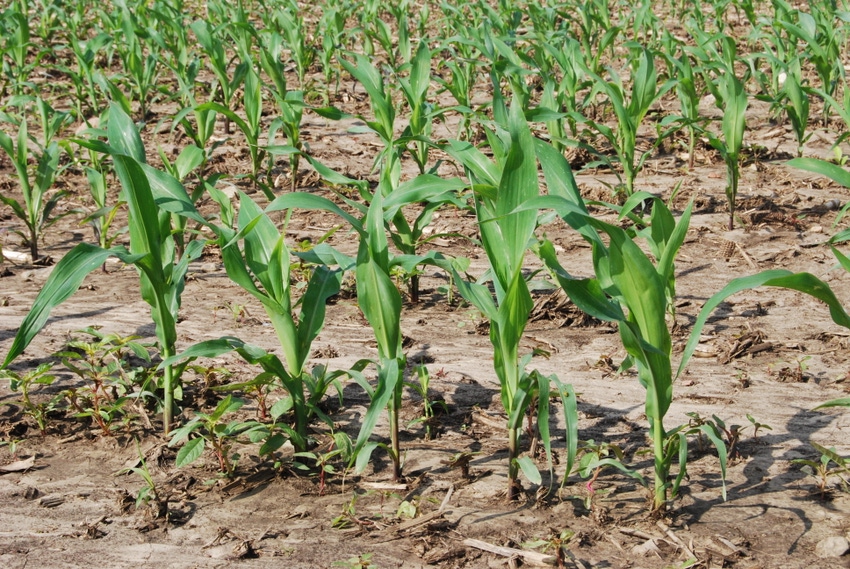
The latest USDA weekly crop survey shows Iowa’s 2018 corn and soybean crops are generally off to a good start. For the week ending June 10, about 97% of the corn has emerged, while 89% of the soybeans are up and growing. But hail and high winds have taken a toll on some fields.
“For the most part, the 2018 Iowa crop is in the ground and is in good condition, with 81% of corn and 78% of soybeans rated good-to-excellent,” notes Iowa Secretary of Agriculture Mike Naig, commenting on the latest statewide survey results. “However, it’s important to recognize that some farmers have faced significant weather challenges as well, with dry conditions a concern in southern Iowa and severe flooding in northern Iowa.
U.S. corn 77% good-to-excellent
The nation’s corn crop as of June 10 was rated 77% good-to-excellent by USDA, just below the grain trade’s estimate of 78%. Soybeans were 74% good-to-excellent, also below the trade estimate of 75%. The U.S. corn crop was 94% emerged; soybeans 83%. Spring wheat was 70% good-to-excellent, while winter wheat was reported 14% harvested, according to USDA.
The complete weekly Iowa Crop Progress and Weather Report is available on the Iowa Department of Ag and Land Stewardship website iowaagriculture.gov or on USDA’s site nass.usda.gov/ia. The report summary follows.
Crop report
While hot and dry conditions allowed many farmers to get caught up on fieldwork, others could do nothing but watch it rain during the week ending June 10, according to USDA’s National Ag Statistics Service. Statewide there were 5.1 days suitable for fieldwork. Activities for the week included hay harvest, wrapping up planting for the year and postemergent weed and fertilizer applications.
Topsoil moisture for the state was rated 4% very short, 15% short, 71% adequate and 10% surplus. Subsoil moisture rated 5% very short, 17% short, 69% adequate and 9% surplus. Drought concerns continued in south central and southeast Iowa as subsoil moisture ratings of very short to short reached 70% or more.
Iowa corn rated 81% good-to-excellent
Statewide as of June 10 for corn, 97% of the crop has emerged with 81% rated in good-to-excellent condition. Soybean growers have 98% of this year’s expected crop planted, two weeks ahead of the five-year average. The survey shows 89% of soybeans have emerged, five days ahead of last year. Iowa’s soybean crop is rated 78% in good-to-excellent condition.
Nearly all of Iowa’s 2018 oat crop has emerged, with 38% headed. And 81% of the oat crop is rated in good-to-excellent condition. Hay condition is 69% good-to-excellent. Pasture conditions rate 60% good-to-excellent. High temperatures have strained pastures in areas of the state lacking rainfall. Cattle continue to experience heat stress.
Weather summary
According to Justin Glisan, IDALS state climatologist, the week of June 4-10 began with warmer temperatures across northern Iowa, ranging from 2 to 7 degrees F above normal. Except for the southwest corner of the state, where average temperatures were 2 to 3 degrees cooler than expected, the rest of Iowa had near normal temps in the upper 70s. On June 4, Swea City in northern Iowa (Kossuth County) reported a high of 91 degrees. Sioux City had a high of 94 degrees, 15 degrees above average on June 5. Midweek through the weekend, temperatures were above-average across most of Iowa; 95 degrees in Rock Rapids (June 6) and Little Sioux (June 7). Lamoni ended the week with a high of 93 degrees.
Severe hail, high winds
On June 4-5 the state was dry, with only a few reports of measurable rainfall from pop-up thunderstorms. Guttenberg recorded 0.2 inch on June 4; Dubuque had 0.05 inch June 5. A line of storms moved between Mason City and Des Moines the morning of June 6. Quarter-size hail was reported in Buchanan County. Widespread activity in the afternoon and evening brought heavy rain, hail and straight-line winds to east central Iowa. Ames received 1.41 inches of rain along with dime-to-quarter size hail; Stanhope had golf ball size hail. Overall, there were more than 50 reports of severe hail and high winds in Iowa.
Thunderstorms brought above-normal amounts of rain, around 0.2 to 0.4 inch, to central Iowa midweek. From June 7 to June 10, flooding occurred in northeast Iowa, including Mitchell and Fayette counties, as slow-moving thunderstorms produced heavy rain. Iowa’s southern third received measurable rainfall on June 10, as a line of thunderstorms slowly progressed across the region. Forest City reported a brief touch down of a rope tornado June 9. Slow-moving storms in northeast Iowa also produced flash flooding in multiple locations June 10.
About the Author(s)
You May Also Like




